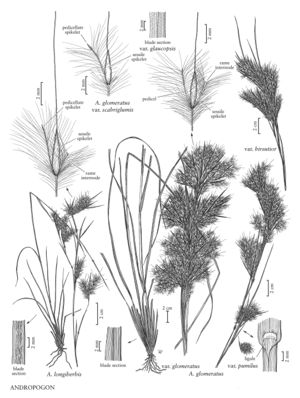Andropogon glomeratus var. hirsutior
Plants usually oblong in the upper portion, sometimes cylindrical. Culms 1-2 m; internodes not glaucous. Sheaths scabrous; ligules ciliate or not, cilia to 0.3 mm; blades green, usually pubescent. Subtending sheaths of inflorescence units (2) 2.4-3.1 (4) mm wide; peduncles 2-5 (8) mm; rames usually 1.7-2.8 cm, not exserted at maturity. Keels of lower glumes usually smooth below midlength, scabrous distally; anthers often retained within the spikelets.
Distribution
Va., Okla., Miss., Tex., La., Ark., N.J., Ala., Tenn., Ga., Ky., Fla., Md., N.C., S.C.
Discussion
Andropogon glomeratus var. hirsutior grows in ditches, swales, bogs, flatwoods, and savannahs of the southeastern coastal plain, often forming very large populations in cleared, low ground.
Selected References
None.
Lower Taxa
"decumbent" is not a number.
